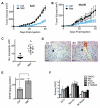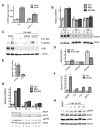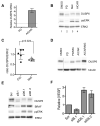Metformin accelerates the growth of BRAF V600E-driven melanoma by upregulating VEGF-A
- PMID: 22576211
- PMCID: PMC3364710
- DOI: 10.1158/2159-8290.CD-11-0280
Metformin accelerates the growth of BRAF V600E-driven melanoma by upregulating VEGF-A
Abstract
The antidiabetic drug metformin has antitumor activity in a variety of cancers because it blocks cell growth by inhibiting TORC1. Here, we show that melanoma cells that are driven by oncogenic BRAF are resistant to the growth-inhibitory effects of metformin because RSK sustains TORC1 activity even when AMP-activated protein kinase (AMPK) is activated. We further show that AMPK targets the dual-specificity protein phosphatase DUSP6 for degradation and this increases ERK activity, which then upregulates the VEGF-A protein. Critically, this drives angiogenesis and accelerates the growth of BRAF-driven tumors in mice. Unexpectedly, however, when VEGF signaling is inhibited, instead of accelerating tumor growth, metformin inhibits tumor growth. Thus, we show that BRAF-driven melanoma cells are resistant to the antigrowth effects of AMPK and that AMPK mediates cell-autonomous and cell-nonautonomous effects that accelerate the growth of these cells in vivo.
Significance: Metformin inhibits the growth of most tumor cells, but BRAF-mutant melanoma cells are resistant to metformin in vitro, and metformin accelerates their growth in vivo. Unexpectedly, VEGF inhibitors and metformin synergize to suppress the growth of BRAF-mutant tumors, revealing a combination of drugs that may be effective in these patients.
Figures







References
Publication types
MeSH terms
Substances
Grants and funding
LinkOut - more resources
Full Text Sources
Other Literature Sources
Medical
Molecular Biology Databases
Research Materials
Miscellaneous

